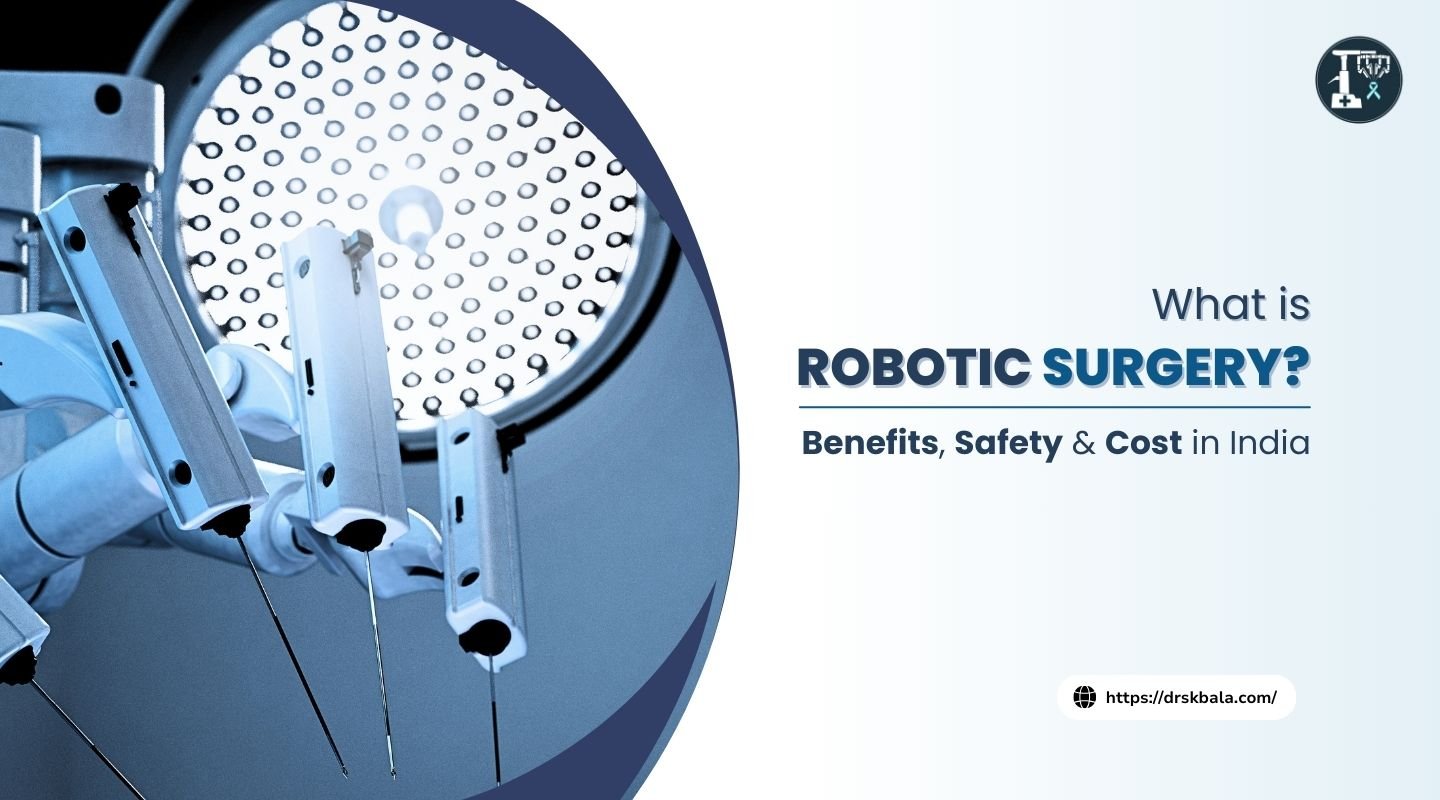What Is Robotic Surgery? Explore Types, Benefits, Safety and Cost in India
Robotic surgery is a form of minimally invasive surgery where a surgeon uses robotic technology to perform complex procedures with precision. This blog is valuable for individuals and families exploring advanced surgical options—it simplifies the concept, clears doubts and helps people make confident, informed decisions about their health.
We’ll cover how robotic surgery works, its benefits for cancer patients, the types of cancers it treats, safety considerations, and essential questions to ask your doctor before choosing this method.
Table of Contents
What Is Robotic Surgery?
Robotic surgery is an advanced form of minimally invasive surgery where the surgeon performs procedures using robotic systems. It involves small incisions through which miniature instruments and a high-definition 3D camera are inserted. These instruments are attached to robotic arms that precisely mimic the surgeon’s hand movements via a console.
The system offers superior vision, flexibility, and control compared to traditional open or laparoscopic surgery. This means greater precision in removing or repairing tissue, sparing healthy areas, minimizing complications, and often enabling faster recovery with less postoperative pain.
How Does Robotic Surgery Work?
Robotic surgery may sound complex, but here’s how the robotic surgery procedure works—step by step—so patients and caregivers can feel confident about the process:

- Console-Based Control: The surgeon doesn’t stand over the patient directly. Instead, they sit at a console beside the operating table, using hand and foot controls to guide robotic arms with extreme precision.
- Robotic Arms in Action: These robotic arms hold a 3D camera and tiny surgical instruments. The camera sends real-time, magnified visuals to the console, giving the surgeon a high-definition, 3D view of the surgical site.
- Enhanced Precision and Movement: The robotic arms translate the surgeon’s hand movements into smaller, steadier motions. This allows for better control in tight spaces and delicate areas—especially crucial in cancer surgeries.
- Surgeon Always in Charge: The system does not operate on its own. Every move is entirely controlled by the surgeon, ensuring human judgment is central at all times.
This advanced setup not only enhances surgical accuracy but also reduces trauma to the body, making recovery quicker and less painful for many patients.
Advantages and Disadvantages of Robotic Surgery

Benefits of Robotic Surgery
Robotic surgery offers several advantages that make it a preferred option for many patients:
- Smaller Incisions: Robotic instruments require only tiny cuts, which means less bleeding, minimal scarring, and a lower risk of wound complications.
- Faster Recovery: Patients typically experience less pain after surgery and return to normal activities sooner than with traditional open procedures.
- Greater Surgical Precision: The technology allows surgeons to perform procedures with incredible accuracy, even in hard-to-reach areas—reducing damage to healthy tissue.
- Lower Risk of Infection: With fewer and smaller incisions, there’s a reduced chance of post-surgical infections and complications.
These benefits of robotic surgery can make a real difference in a patient’s surgical journey—offering not just better outcomes, but also an easier road to recovery.
Disadvantages of Robotic Surgery
While robotic surgery offers many benefits, it’s important for many patients and caregivers to be aware of its limitations too:
- Higher Cost: Robotic systems are expensive to operate, which can make the procedure more costly for patients, depending on the hospital or insurance coverage.
- Not Suitable for All Cases: Some advanced or emergency cases may still require traditional surgery based on tumor size, location, or patient condition.
- Availability & Expertise: Robotic surgery requires specially trained surgeons and high-end infrastructure—not all hospitals may offer it.
- Longer Setup Time: Preparing and configuring the robotic system takes additional time before surgery can begin.
Read More: Advantage & Disadvantage of Robotic Surgery
Common Types of Robotic Surgery and Their Uses
Robotic surgery is widely used across medical specialties to treat both cancerous and non-cancerous conditions. Here’s how it applies to specific types:

- Urologic Surgery: Robotic technology is frequently used for prostate cancer operations, as well as the removal of kidney and bladder tumors. It also helps treat benign prostate enlargement and repair ureteral strictures. Patients heal faster with less trauma.
- Colorectal and GI Surgery: Surgeons use robotic tools to remove colon and rectal tumors, perform gallbladder and hernia surgeries, and treat acid reflux. The enhanced precision is especially helpful in these complex abdominal areas.
- Gynecologic Surgery: Robotic surgery supports treatment of cervical, ovarian, and uterine cancers. It is also used for non-cancer procedures such as hysterectomies for fibroids or endometriosis, fibroid removal (myomectomy) and pelvic organ prolapse repairs. That’s how these reduce pain and speed recovery.
- Hepatobiliary and Pancreatic Surgery: Robotic techniques also play an important role in these surgeries. Surgeons can perform delicate tumor removals in the liver, gallbladder and pancreas with better control and less blood loss.
- Thoracic and Cardiac Surgery: Robotics are used for lung tumor removals and mediastinal tumor resections. This technology is also used for coronary artery bypass grafting and mitral valve repairs. It offers patients less invasive alternatives to traditional open-heart surgery.
- Head and Neck Surgery: Robotic technology is increasingly used in transoral robotic surgery (TORS) for throat tumors and treatment of obstructive sleep apnea, providing patients with less invasive options and quicker recovery.
Overall, robotic surgery covers a broad range of treatments. From cancer care to repairing benign conditions, different types of robotic surgery continue to expand as technology advances. Its ability to combine precision with minimal invasiveness makes it a valuable option for many patients seeking advanced surgical care.
Is Robotic Surgery Safe?
Yes—robotic surgery is considered a safe and reliable technique when performed by skilled surgeons. It is FDA-approved and used in leading hospitals across the world for various types of surgeries.
Multiple clinical studies have shown that robotic surgery often results in fewer complications, less blood loss and quicker recovery compared to traditional or laparoscopic surgery. However, like any medical procedure, safety also depends on the surgeon’s expertise, hospital setup and the patient’s specific condition.
Robotic Surgery Costs in India
Robotic surgery costs in India generally range from ₹2,00,000 to ₹10,00,000, influenced by factors such as the type of surgery (e.g., prostate, gynecological or cardiac), the hospital’s location and the surgeon’s experience. Metropolitan cities like Mumbai, Delhi, Bengaluru, Chennai and Kolkata often have higher fees due to their state-of-the-art facilities.
Although the cost is higher compared to traditional surgery, robotic procedures often lead to shorter hospital stays, less pain and quicker recovery. That’s how it is cost-effective overall. Patients should verify insurance coverage beforehand, as many private health plans partially cover robotic surgery and some hospitals offer financing options to help manage expenses.
Take the Next Step
Robotic surgery represents a significant advancement in modern treatment—offering precision, minimal invasiveness and faster recovery. For anyone exploring surgical options, understanding how this technology works can empower you to make informed, confident decisions about your care.
If you’re considering robotic surgery or simply want to explore whether it’s right for you, now is the time to act.
Book a consultation with one of the best robotic surgeons in Kolkata.
Your next step could be the most precise move toward better health. Take action now—your health deserves no delay.



